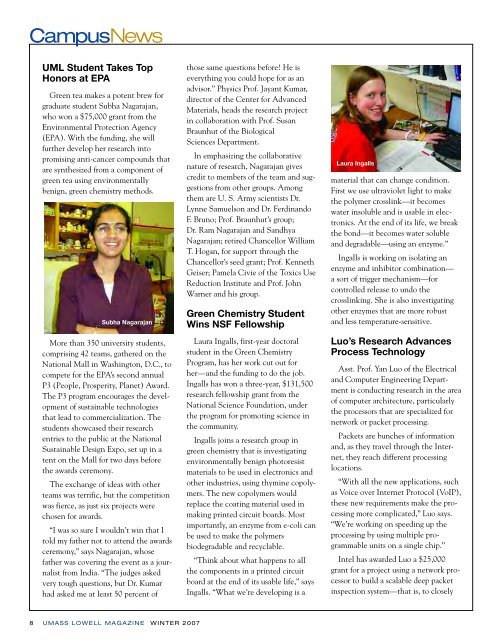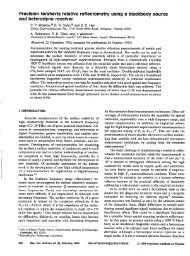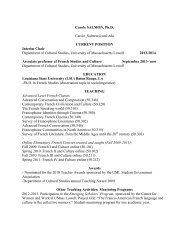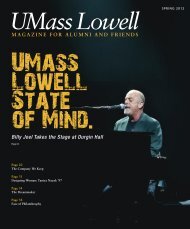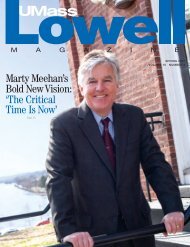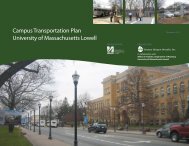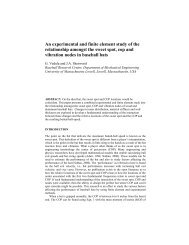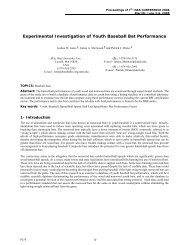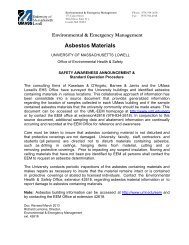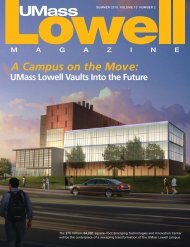THE HOGAN YEARS: - University of Massachusetts Lowell
THE HOGAN YEARS: - University of Massachusetts Lowell
THE HOGAN YEARS: - University of Massachusetts Lowell
Create successful ePaper yourself
Turn your PDF publications into a flip-book with our unique Google optimized e-Paper software.
CampusNews<br />
UML Student Takes Top<br />
Honors at EPA<br />
Green tea makes a potent brew for<br />
graduate student Subha Nagarajan,<br />
who won a $75,000 grant from the<br />
Environmental Protection Agency<br />
(EPA). With the funding, she will<br />
further develop her research into<br />
promising anti-cancer compounds that<br />
are synthesized from a component <strong>of</strong><br />
green tea using environmentally<br />
benign, green chemistry methods.<br />
Subha Nagarajan<br />
More than 350 university students,<br />
comprising 42 teams, gathered on the<br />
National Mall in Washington, D.C., to<br />
compete for the EPA’s second annual<br />
P3 (People, Prosperity, Planet) Award.<br />
The P3 program encourages the development<br />
<strong>of</strong> sustainable technologies<br />
that lead to commercialization. The<br />
students showcased their research<br />
entries to the public at the National<br />
Sustainable Design Expo, set up in a<br />
tent on the Mall for two days before<br />
the awards ceremony.<br />
The exchange <strong>of</strong> ideas with other<br />
teams was terrific, but the competition<br />
was fierce, as just six projects were<br />
chosen for awards.<br />
“I was so sure I wouldn’t win that I<br />
told my father not to attend the awards<br />
ceremony,” says Nagarajan, whose<br />
father was covering the event as a journalist<br />
from India. “The judges asked<br />
very tough questions, but Dr. Kumar<br />
had asked me at least 50 percent <strong>of</strong><br />
those same questions before! He is<br />
everything you could hope for as an<br />
advisor.” Physics Pr<strong>of</strong>. Jayant Kumar,<br />
director <strong>of</strong> the Center for Advanced<br />
Materials, heads the research project<br />
in collaboration with Pr<strong>of</strong>. Susan<br />
Braunhut <strong>of</strong> the Biological<br />
Sciences Department.<br />
In emphasizing the collaborative<br />
nature <strong>of</strong> research, Nagarajan gives<br />
credit to members <strong>of</strong> the team and suggestions<br />
from other groups. Among<br />
them are U. S. Army scientists Dr.<br />
Lynne Samuelson and Dr. Ferdinando<br />
F. Bruno; Pr<strong>of</strong>. Braunhut’s group;<br />
Dr. Ram Nagarajan and Sandhya<br />
Nagarajan; retired Chancellor William<br />
T. Hogan, for support through the<br />
Chancellor’s seed grant; Pr<strong>of</strong>. Kenneth<br />
Geiser; Pamela Civie <strong>of</strong> the Toxics Use<br />
Reduction Institute and Pr<strong>of</strong>. John<br />
Warner and his group.<br />
Green Chemistry Student<br />
Wins NSF Fellowship<br />
Laura Ingalls, first-year doctoral<br />
student in the Green Chemistry<br />
Program, has her work cut out for<br />
her—and the funding to do the job.<br />
Ingalls has won a three-year, $131,500<br />
research fellowship grant from the<br />
National Science Foundation, under<br />
the program for promoting science in<br />
the community.<br />
Ingalls joins a research group in<br />
green chemistry that is investigating<br />
environmentally benign photoresist<br />
materials to be used in electronics and<br />
other industries, using thymine copolymers.<br />
The new copolymers would<br />
replace the coating material used in<br />
making printed circuit boards. Most<br />
importantly, an enzyme from e-coli can<br />
be used to make the polymers<br />
biodegradable and recyclable.<br />
“Think about what happens to all<br />
the components in a printed circuit<br />
board at the end <strong>of</strong> its usable life,” says<br />
Ingalls. “What we’re developing is a<br />
Laura Ingalls<br />
material that can change condition.<br />
First we use ultraviolet light to make<br />
the polymer crosslink—it becomes<br />
water insoluble and is usable in electronics.<br />
At the end <strong>of</strong> its life, we break<br />
the bond—it becomes water soluble<br />
and degradable—using an enzyme.”<br />
Ingalls is working on isolating an<br />
enzyme and inhibitor combination—<br />
a sort <strong>of</strong> trigger mechanism—for<br />
controlled release to undo the<br />
crosslinking. She is also investigating<br />
other enzymes that are more robust<br />
and less temperature-sensitive.<br />
Luo’s Research Advances<br />
Process Technology<br />
Asst. Pr<strong>of</strong>. Yan Luo <strong>of</strong> the Electrical<br />
and Computer Engineering Department<br />
is conducting research in the area<br />
<strong>of</strong> computer architecture, particularly<br />
the processors that are specialized for<br />
network or packet processing.<br />
Packets are bunches <strong>of</strong> information<br />
and, as they travel through the Internet,<br />
they reach different processing<br />
locations.<br />
“With all the new applications, such<br />
as Voice over Internet Protocol (VoIP),<br />
these new requirements make the processing<br />
more complicated,” Luo says.<br />
“We’re working on speeding up the<br />
processing by using multiple programmable<br />
units on a single chip.”<br />
Intel has awarded Luo a $25,000<br />
grant for a project using a network processor<br />
to build a scalable deep packet<br />
inspection system—that is, to closely<br />
8 UMASS LOWELL MAGAZINE WINTER 2007


